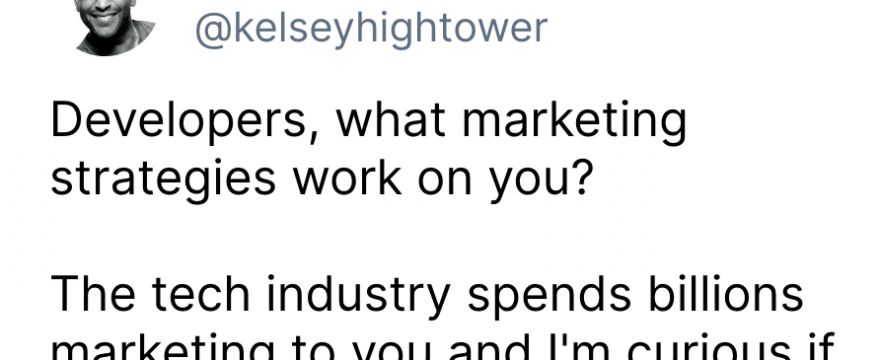The lead form full of invasive requests sends them to the Back button. They bristle at the words “Contact sales for documentation.” And that stroll through the expo hall? Solely about the freebies. My own experience as a developer and career spent helping other developers is what led me to say that Developer Marketing Does Not Exist.
You may be familiar with the traps to avoid, but where does that leave those of us who want to reach a dev audience? What do developers themselves think gets their attention and makes them give your dev tool the time of day—and, maybe, their company’s money?
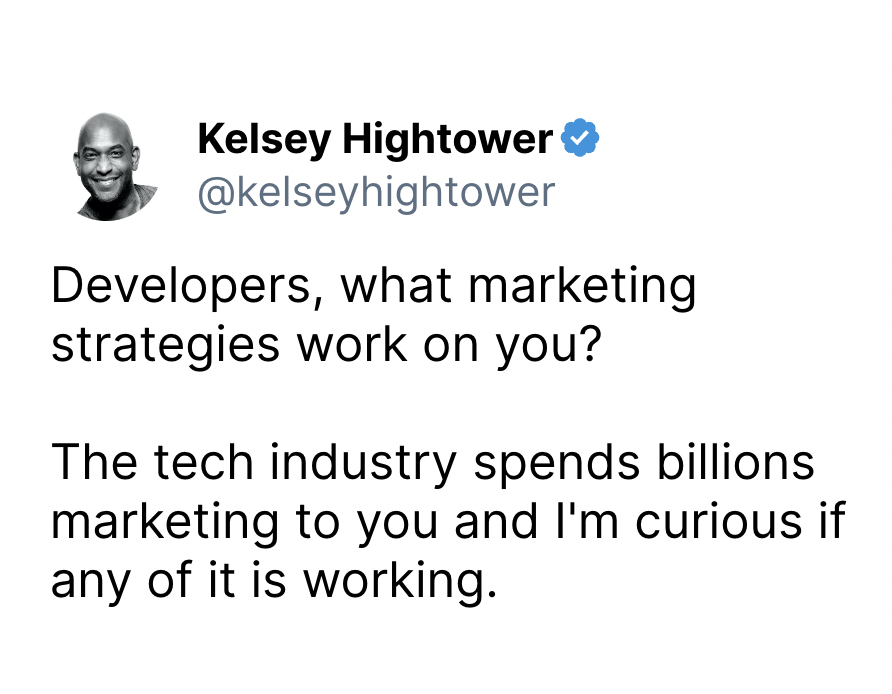
Kelsey Hightower asked, and developers responded. There are more than 300 replies to the original message, which we’ve read and categorized.
In their own words, developers want marketers to know these three pieces of advice:
-
- Don’t try to impress us, try to help us.
-
- Don’t make it feel like marketing.
-
- Let us get our hands dirty (with your product).
Marketers are already taking notice:
As a member of the marketing org of a company that sells developer tools, 👀👀👀👀👀👀👀👀 on this thread
— Josh Kodroff
And if you want to earn your way into their command lines, inboxes, and hearts, so should you.
Don’t Try to Impress Us, Try to Help Us
Flashy videos, hyped-up sales pitches, and emotion-driven copy might work with consumer audiences. Developers, on the other hand, have learned to filter out the noise. They’re skeptical of bold claims, and for good reason—they’re usually too good to be true. What they do respond to is a genuine focus on solving their pain points and making their lives easier.
When developer Mark Sanborn talks about marketing, you can sense his unease with traditional tactics. Flaunting messages meant to impress often backfire with, at best, closing your browser tab.
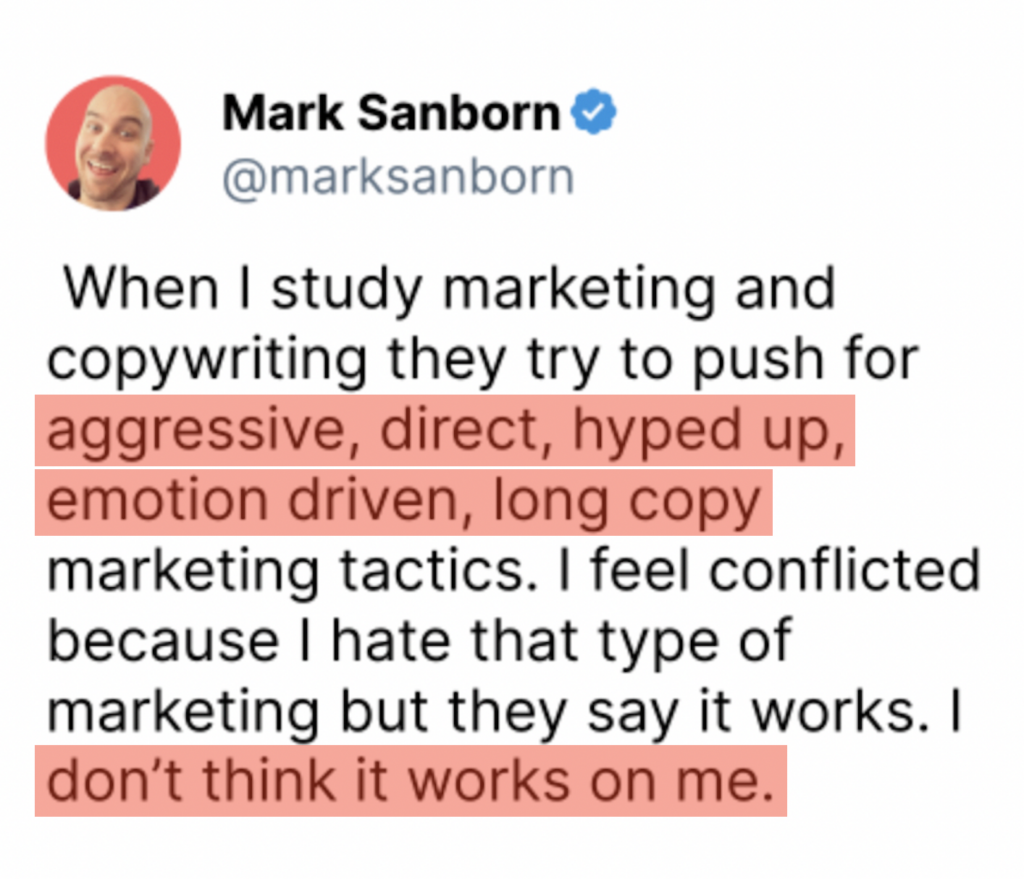
Developers want to see clearly how your product works, the problems it solves, and the value it provides. That does not require fluff or gimmicks. Straight talk, transparent messaging, and truly helpful content and resources? Now you’ve got their attention.
If you can showcase your technical expertise while guiding them toward solutions, you’ll not only gain devs’ respect but their enthusiasm as well. Bonus points if you can show how your product can go beyond addressing their pain points, helping them discover new use cases, improve workflows, or build amazing things!
Aim for marketing content that’s hype-less and helpful:
The only thing that works is if you show up high in the search results with enough information there to satisfy me that you can solve the problem I’m searching about.
— Brian Alspach
Show the solution without hyping your product in the process. If they buy the concept, they will buy the product. Approach them without overpromising propaganda and be sure to share use cases.
Inspiration to Reach a Technical Audience
Skip the fluff and earn real developer trust. Subscribe for weekly insights on how to market without gimmicks and create experiences that devs respect, remember, and recommend.
Don’t Make It Feel Like Marketing
As you talk to developers, you may notice apparent contradictions. For example, one dev doesn’t want to hear about your dev tool at all. Yet, another dev—or even the same dev—may want a clear, hype-free description of what your product does. Those actually aren’t a contradiction at all. They’re both asking you not to market to them.
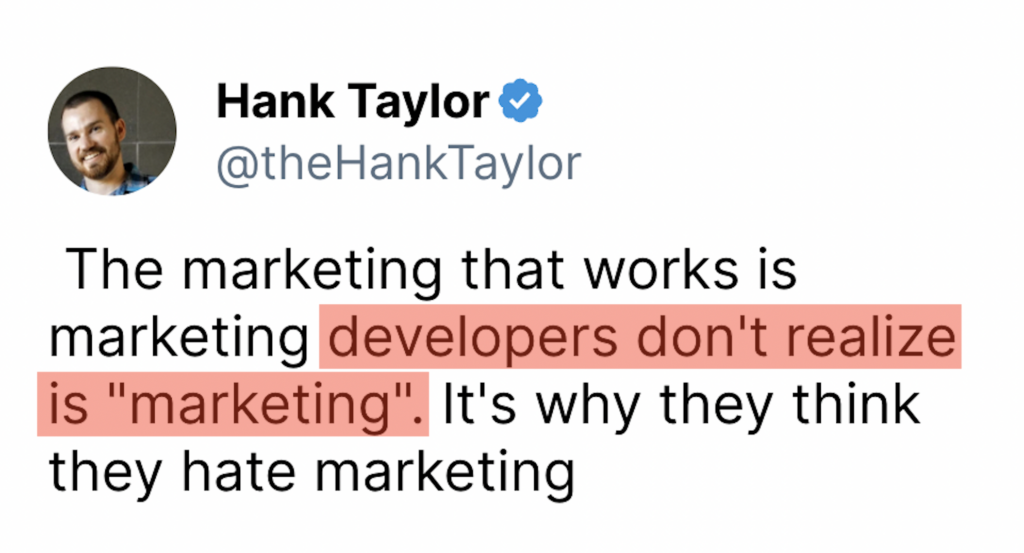
Developers inspect everything to see how it works, including your marketing messages. Their pattern of skepticism—which helps them build fault-tolerant software—matches the many signals they’ve seen before. Typical marketing tactics come across as tricky and suspicious, even if they’re well-meaning.
Classic marketing campaigns can also prevent developers from understanding how a technical tool works. That’s not just education in the “help us” sense of the previous section. Your marketing should focus on uncovering use cases and, in some cases, providing transparency to the tech stack.
Consequently, the most successful marketing—the thing that makes a developer attracted to and adopt your product—probably doesn’t look like marketing:
If you understand it’s a marketing strategy used on you, it’s not working on you
— Ihar Bury
Some argue that great marketing is marketing that goes unnoticed. That may be true, but most audiences will forgive blatant promotion, or at least tolerate it. Devs will rebel against it.
For example, getting reliable lead form contact information from developers can be tough. They can smell sales pitches three clicks away. Yet, those same developers will cover their laptops in open-source software stickers.
So what’s the difference? The form presents as obvious marketing, while the adhesive freebies feel like supporting the community. When you can suss out the difference, you understand developers.
Let Us Get Our Hands Dirty (With Your Product)
Once you’ve attracted developers to your dev tool, they will want to see it in action—ideally, to try it themselves. Developers want to confirm their use case is possible and that your dev tool fits into their workflow. It’s great to review the documentation (they want that, too), but nothing compares to a first-hand experience. So marketers should avoid putting barriers in the way.
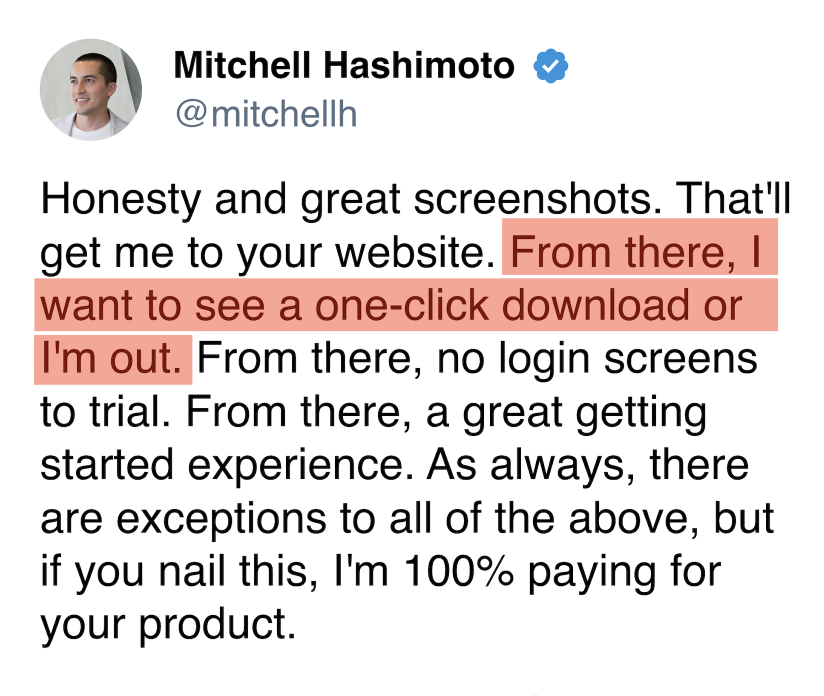
Mitchell Hashimoto, founder of HashiCorp, shares the common boundaries put between developers and a new product.
You may not be able to avoid login screens for SaaS dev tools, but you can find ways to streamline the process. Show how devs can use your dev tool, even if it’s only through command line interactions. Help developers imagine the experience, then let them try it themselves.
Stripe famously lets you test API calls without an account. In its early days, the company would even let you explore the dashboard.

A dashboard is a logged-in experience for most dev tools. Stripe knew devs would be skeptical of signup, so they built their product to make it optional. “Save your account later,” Stripe said, building huge amounts of developer trust.
But you don’t need to go as far as Stripe. You’ll do better than most if you just avoid eroding developer trust:
if I see “Book a demo” or “Talk to Sales” I am out
— Yacine Hmito
Developers want to get their hands dirty. That’s how they’ll decide whether to take the next step with your product. Find a way to help them get what they want: a free trial, some hands-on experience, and no contact forms in the way.
Get Developers to Love Your DevTool
Now that you know the marketing that works for developers, you can give them what they want. Developers aren’t looking for hype—they want help. They want marketing that doesn’t feel like marketing at all. Show that you can solve their specific developer problems and they’ll not only try your product but also recommend it to others.
You can turn skeptical developers into enthusiastic advocates for your devtool. At EveryDeveloper, we specialize in understanding and applying these unique insights. Let us help you implement these lessons to build authentic connections and provide real value.
Inspiration to Reach a Technical Audience
Skip the fluff and earn real developer trust. Subscribe for weekly insights on how to market without gimmicks and create experiences that devs respect, remember, and recommend.
